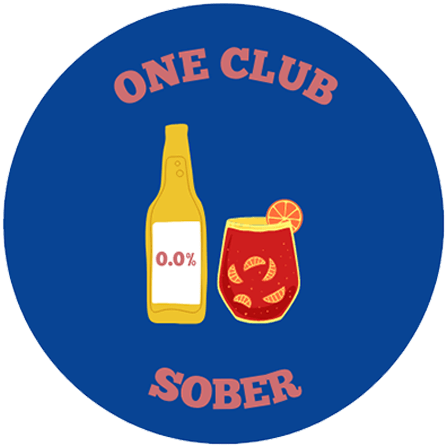While I’m out shopping for alcohol-free drinks, I often encounter non-alcoholic beers, wines, or spirits labeled with different terms such as ‘alcohol-free,’ ‘non-alcoholic,’ ‘de-alcoholized,’ ‘0.0%,’ or ‘0.5%.’
This variety of labels can be confusing for those new to non-alcoholic drinks. After all, some non-alcoholic drinks contain zero traces of alcohol, while others may have 0.5% ABV (Alcohol By Volume) or less.
So, what exactly is the difference between all these different terms and labels?
Unfortunately, when it comes to labeling a drink as non-alcoholic, there isn’t a worldwide standard practice. Depending on the country you’re in, a non-alcoholic drink might contain zero alcohol or up to 0.5% alcohol.
That said, here’s what you should know about non-alcoholic drinks with 0.5% ABV labels.

1. 0.5% ABV is the same amount of alcohol in a ripe banana
Most people I talk to are surprised to learn that natural foods can also contain small traces of alcohol. For example, a glass of orange juice can contain up to 0.5% alcohol, and a ripe banana has around 0.4% alcohol.
I often see people getting confused by the 0.5% alcohol content, which can sound like a significant amount if you’re not aware of how minuscule it really is!
Take, for instance, this recent conversation I had with a follower on our One Club Sober TikTok video:

I enjoy comparing some of my favorite food and drink items with non-alcoholic drinks.
For example, did you know that commercially sold kombucha has around 0.5% alcohol, while home-brewed kombucha has around 1-2.5% alcohol? That’s higher than I thought!
Here is a comparison table of the alcohol content in different food items versus a non-alcoholic drink with 0.5% ABV:
| Item | ABV (%) |
|---|---|
| Apple Juice | 0.2% |
| Non-Alcoholic Beer | 0.5% or less |
| Commercially-Bought Kombucha | 0.5% |
| Orange Juice | 0.5% |
| Soy Sauce | 2% |
Since we don’t consider these natural foods as alcohol, then by logic any drink with 0.5% ABV or less would be non-alcoholic.
Plus, your body metabolizes that tiny trace of alcohol faster that you can feel any effect.
2. 0.5% ABV is not considered alcohol-free in many countries
When it comes to labeling a drink as non-alcoholic, there isn’t a worldwide standard labeling practice. Depending on which country you’re in, a non-alcoholic drink might contain zero alcohol or up to 0.5% alcohol.
That said, alcohol-free drink labels often refer to 0.0 ABV with no traces of alcohol.
In the United States, the FDA does not consider “non-alcoholic” to be the same as “alcohol free” or “dealcoholized”. ‘Alcohol-free’ can only be used when the drink has zero detectable alcohol. If it contains 0.5% ABV, then it would have to be classified as ‘non-alcoholic.’
In the UK, 0.05% to 0.5% alcohol are classed as ‘de-alcoholised’. Similarly, in Australia, ‘alcohol-free’ must contain zero traces of alcohol, up to 0.05% alcohol, while a non-alcoholic drink can contain 0.5% or less alcohol by volume.
In countries like the UAE, Qatar, and Saudi Arabia, rules are much stricter and drinks with 0.5% ABV are considered alcoholic drinks. Alcohol-free drinks must have absolutely zero alcohol to be considered alcohol-free.
This is why in the 2022 World Cup, Bud Zero was the official “beer” sponsor because it has zero traces of alcohol.
| Country | 0.0 ABV | 0.5 ABV |
|---|---|---|
| United States | Alcohol-Free | Non-Alcoholic |
| European Union | Alcohol-Free | Non-Alcoholic |
| United Kingdom | Alcohol-Free | Non-Alcoholic / De-Alcoholised |
| Australia | Alcohol-Free | Non-Alcoholic / De-Alcoholised |
| UAE, Qatar, Saudi Arabia | Alcohol-Free | Alcoholic |
3. 0.5% alcohol can’t get you drunk

I have never gotten drunk (or even the slightest tipsy) from drinking non-alcoholic drinks with 0.5% ABV. I even did a breathalyzer test after drinking a non-alcoholic beer.
Even if you were to binge-drink non-alcoholic drinks, it would be like trying to get drunk by binge-drinking orange juice or eating lots of ripe bananas. Not impossible, but highly unlikely.
Firstly, it would take you finishing 10 cans or more of 0.5% non-alcoholic drinks to even feel a slight buzz.
Considering that most alcoholic drinks have around 5% ABV, you are far from getting drunk with a 0.5% non-alcoholic drink.
However, if you are a recovering alcoholic, you might want to skip the 0.5% alcohol drinks. While the alcohol content won’t make you drunk, research has shown that non-alcoholic beers provide sensory cues that simulate alcoholic beer, which can lead to a relapse.
My take is: You’ll need to make your own judgement on this.
4. 0.5% ABV is not halal
Unfortunately, any drink with traces of alcohol is not halal, because even the slightest trace of alcohol is not permitted in Islam. Islam, like many other religions, has strict rules about alcohol consumption.
0.5% non-alcoholic beers are generally brewed using the traditional brewing process, where the alcohol formed during fermentation is boiled away or removed via reverse osmosis and pumped out with water. These processes are generally not considered halal.
If you are looking for an alcohol-free beer that is halal, the best recommendation would be to look for halal certification. Not all non-alcoholic beer companies apply for halal certification, though.
Another option is to look for beers with zero percent alcohol and zero traces. Alcohol-free beers are brewed using a process that does not involve fermentation at all, so alcohol isn’t created.
As mentioned previously, Bud Zero has zero alcohol and was the sponsor of the 2022 World Cup in Qatar, a country with strict alcohol rules.
Conclusion
I hope this guide clarifies everything you need to know about 0.5% ABV, what is considered non-alcoholic, and the debate between 0.0% versus 0.5% ABV.
If you are looking for a beer with zero traces of alcohol due to health, religion or personal reasons, be sure to look at the labels and only select the ones with zero alcohol.
